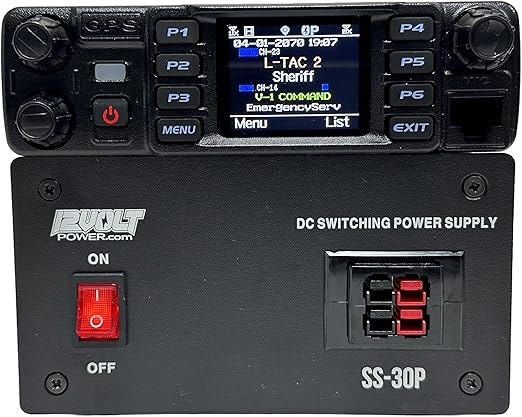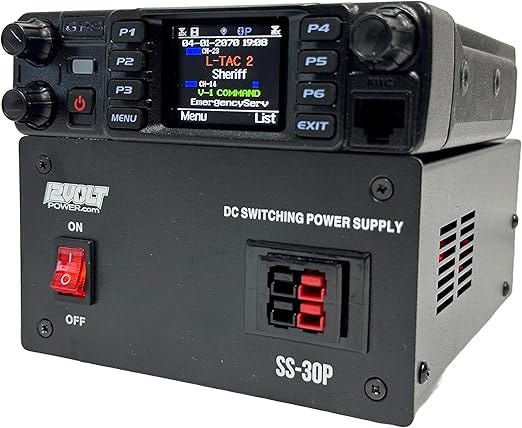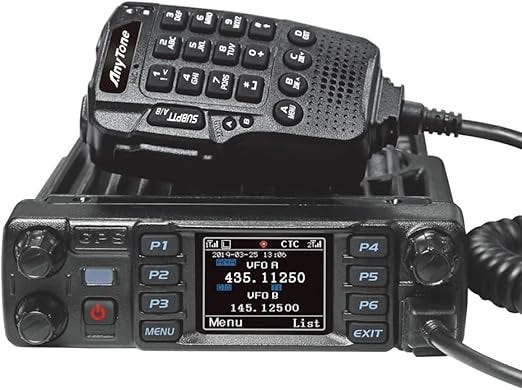AnyTone AT-D578UVIII Plus — In-Depth Review of the Tri-Band DMR Mobile Radio
Introduction
The AnyTone AT-D578UVIII Plus arrives as a compelling feature-packed mobile transceiver aimed at hams who want a single radio that covers modern digital voice (DMR), solid analog performance, APRS location capability, air band reception, Bluetooth audio, and a usable mobile power bundle. It’s a heavy hitter on paper: tri-band coverage, high mobile output (50 W on VHF, 45 W on UHF), APRS TX/RX, Bluetooth for audio and programming, a loud external speaker, and a 30 A power supply included in many packages. In this review I’ll walk through the real-world strengths and tradeoffs so you can decide whether it’s the right mobile radio for your truck, shack, or portable base.
What’s in the Box and First Impressions
Contents include the mobile head unit and body, a handheld style mic, DC power leads, mounting hardware and bracket, the external speaker (or integrated front speaker depending on configuration), and commonly the 30 A desktop power supply when sold as a kit. Out of the box the radio feels solid and purpose-built: the chassis is metal, the microphone quality is acceptable for mobile use, and the included power supply is a practical bonus for users who want a plug-and-play desktop/mobile setup without having to source a separate PSU.
Build Quality, Controls and Installation
AnyTone keeps the physical controls familiar to mobile operators: a main rotary for volume and selection, a set of programmable buttons, and a fairly readable color display. The construction is robust — the radio and bracket feel like they’ll handle a vehicle environment — but the microphone clip and some plastics are standard mid-market quality rather than premium. Mounting is straightforward: the radio body tucks under a dash or on a shelf and the head can be panel-mounted or remote-mounted depending on your dash space and wiring plan.
Display and User Interface
The full-color display is large enough to show channel, mode, signal meters and small menus at a glance. AnyTone’s menus are feature-dense; that’s great for power users but means the learning curve is steeper for newcomers. Expect to lean on the manual and programming software initially — once you’ve set up channels, zones and DMR contacts, day-to-day use becomes simple.
Audio, Bluetooth and Speaker
Audio performance is one of the Plus model’s highlights. The built-in/loud external speaker delivers clear intelligibility at high volume — useful in noisy vehicle environments. Bluetooth audio works well for wireless headsets and can also handle audio streaming and phone-paired functions depending on how the radio is configured. Bluetooth pairing is generally stable; audio latency is low enough for normal voice work, though wireless headsets are never as low-latency or consistent as a wired mic in marginal RF conditions.
RF Performance — Receive
Receiver performance is strong across the intended bands. Sensitivity for both analog and DMR digital modes is good, and the receiver handles strong signals without badly desensitizing in most setups. One very useful capability is air band reception: the radio can pick up AM airband transmissions, making it a versatile scanner as well as a two-way transceiver. As with many multifunction radios, the sheer breadth of RX coverage means you’ll want to be familiar with the menu options to tailor filters and squelch for the best experience in crowded bands.
RF Performance — Transmit
The radio delivers robust mobile transmit power: about 50 watts on VHF and roughly 45 watts on UHF in typical configurations. That extra mobile power makes it easier to hit local repeaters, portable stations, and distant contacts when mobility is required. Heat is a factor at high power; continuous high-power operation is best supported with good ventilation and, if installed in a vehicle, careful attention to mounting to allow airflow around the chassis. Power keying is crisp and audio on transmit is well processed — DMR audio especially comes across clear when properly configured.
DMR Features and Digital Operation
AnyTone’s implementation of DMR is mature. You’ll find full support for DMR ID programming, private and group calls, talkgroups, color-coded contacts, and multiple channels per zone. The radio handles slot selection, TS, and repeaters reliably. Digital voice quality across DMR is typically good: strong links yield very clear audio, and the radio’s processing keeps background noise under control. Like most DMR radios, you’ll want to pair it with decent programming software and keep your contact/talkgroup lists organized to get the best experience. Hotspot and reflector connectivity is straightforward if you use a networked setup.
APRS Location Data (RX/TX)
APRS receive and transmit capabilities are a big plus for mobile operators who also want position reporting. The radio supports APRS location data — useful for tracking and situational awareness. Some models rely on an internal GNSS receiver for position, while others support external GPS sources or phone GPS via Bluetooth; check how your particular unit sources GPS before assuming internal GPS is present. APRS messaging, beaconing, and digipeater interactions work as expected, and having APRS on the same mobile unit you use for voice/Digital makes for a tidy single-box solution.
Airband Reception
Airband RX is a practical addition for operators who like to monitor local traffic, flight info, or need situational awareness when traveling near airports. The radio’s ability to receive airband frequencies in AM mode adds scanner functionality without requiring a dedicated aviation receiver.
Power Supply and Electrical Considerations
The inclusion of a 30 A power supply in many retail bundles is very attractive — it’s the right size for the radio’s mobile output and leaves headroom for occasional full-power bursts. When wiring to a vehicle battery, fuse sizing and wire gauge remain critical: use heavy gauge positive/negative leads and a proper in-line fuse near the battery. Expect the radio to draw considerable current at high power; plan your wiring and heat dissipation accordingly. Idle power draw in standby is modest, but any mobile operating at high power for extended periods will produce heat and higher current draw.
Programming, Software and Memory Management
Modern AnyTone radios are feature-rich but can be complex. The desktop programming software lets you build channel lists, map DMR contacts, configure APRS parameters, set Bluetooth profiles, and more. There is an initial time investment to learn the software and the radio’s menu structure, but once set up, you can swap between roaming profiles and zones easily. For operators who prefer simple operation, having a well-prepared codeplug (programmed channel list) is highly recommended.
Thermals, Reliability and Durability
Under normal mobile use the radio runs within expected temperatures; long transmissions at full power generate heat and are the main stressor. Build quality and internal cooling are designed for vehicle environments, but continuous maximum power should be avoided unless you have a dedicated ventilated enclosure. Reliability in the field is generally good for AnyTone units when installed correctly and supplied with clean DC power.
Pros
• All-in-one mobile: tri-band coverage plus airband RX and APRS makes it versatile.
• Strong mobile transmit power (50W VHF / 45W UHF) for reliable coverage.
• DMR support is full featured — good for repeaters, private calls and hotspots.
• Bluetooth audio and APRS add modern convenience.
• Loud, intelligible audio for vehicle use.
• Bundled 30 A power supply (in many kits) is a practical bonus.
Cons and Tradeoffs
• Feature density equals complexity — initial setup and programming can be a learning curve.
• Continuous high-power operation requires attention to ventilation and power wiring.
• Some users prefer more tactile, larger physical knobs for fast tuning; the compact head design is a compromise for dashboard mounting.
• Depending on model configuration, internal GPS may or may not be present — verify APRS GPS sourcing if that’s critical.
Who Should Buy It
This radio targets the operator who wants a single mobile unit capable of modern digital modes, APRS, and a versatile receive range (including airband). It’s ideal for vehicle mobile operators, emergency comms volunteers, and hams who want DMR plus analog in one box without the need to carry separate scanners or APRS trackers.
Who Might Look Elsewhere
If you want an ultra-simple plug-and-play mobile with minimal programming, or if you rely on continuous full-power transmissions in harsh environments without extra cooling, you might favor a more specialized radio or a higher-end mobile with larger heat sinks. Also, if you need integrated features not present in particular variants (for example, guaranteed internal GNSS or particular band plans), check the exact spec sheet for the unit you’re buying.
Practical Tips for Buyers and Installers
• Spend time creating a clean codeplug before you install it in the vehicle — it saves a lot of frustration.
• Use a quality coax and antenna matched to the bands you use; performance is only as good as the antenna system.
• Ensure you have proper ventilation if you operate at high power often.
• Verify whether your unit has internal GPS if APRS is important; otherwise plan for an external GPS or Bluetooth phone GPS.
• Keep firmware updated when manufacturer updates are available — updates often refine DMR features and fix bugs.
Final Verdict
The AnyTone AT-D578UVIII Plus is a compelling, feature-dense mobile radio that blends high mobile output, modern digital voice functionality, APRS capability, airband reception and Bluetooth convenience into a single package. It’s an excellent value proposition for the technically inclined operator who wants flexibility and the ability to handle both legacy analog work and modern DMR networks from the same installation. The main tradeoff is complexity — there’s a learning curve — and the need to manage power and heat at high output. For operators willing to invest a little time in setup and quality installation, this radio delivers wide capability and dependable performance.





